Artificial intelligence (AI) has been one of the most transformative technologies of the 21st century, with a potential market size projected to reach $126 billion by 2025. - Economic Times
AI tools are used in various applications, from natural language processing and speech recognition to image and video analysis, recommendation systems, and autonomous vehicles.
According to a report by McKinsey Global Institute, AI has the potential to create $13 trillion in global economic activity by 2030. Businesses and organizations of all sizes are already adopting AI tools to improve efficiency, automate processes, and gain insights from large datasets.
AI tools are also used in healthcare to assist with diagnosis and treatment, in education to personalize learning, and in transportation to improve safety and efficiency.
With AI tools' increasing availability and affordability, their impact will undoubtedly continue to grow in the coming years. In light of this surge, their impact is only poised to magnify in the coming years. This is why this article presents you with a curated list of 26 Generative AI Tools designed to disrupt every major sector with their revolutionary potential.
Want to keep up with the latest
AI advancements? Check out our up-to-date AI Tracker.
Explore Now26 Generative AI Tools: Disrupting every prominent sector
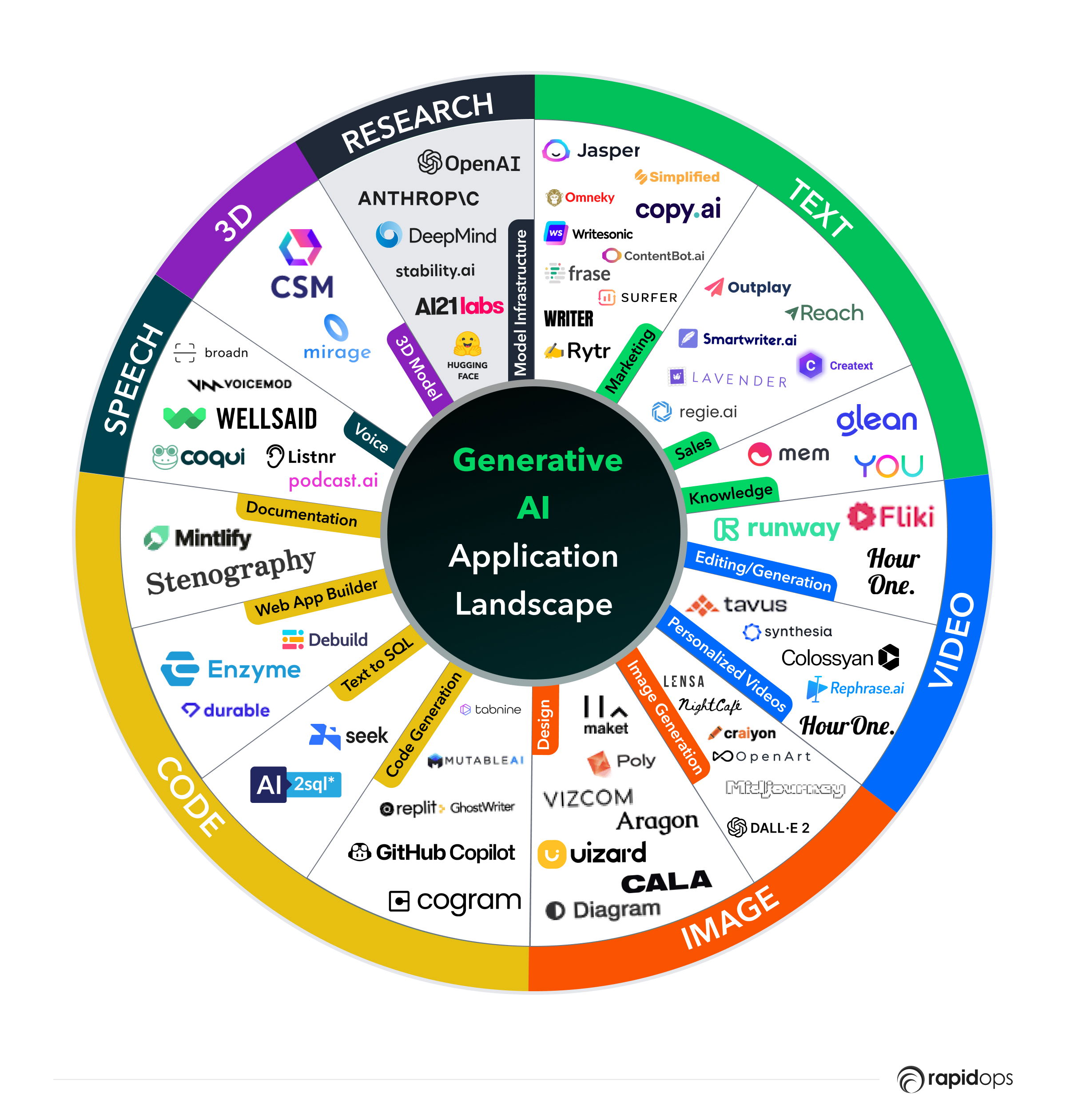
In this content piece, we will help you explore various generative AI tools, the popular ones in each category, discuss their applications, and provide the necessary details surrounding them.
Model infrastructure
Model infrastructure refers to the tools and resources that support machine learning model development, deployment, and management. Developers can seamlessly use the frameworks, libraries, APIs, and other interfaces as part of the model infrastructure to build and integrate models with various applications.
1. DataRobot
DataRobot is a commercial machine-learning platform that provides various tools for building and deploying machine-learning models. It includes tools for data preparation, model training, deployment, and automated machine-learning features that can help users quickly build and deploy models. DataRobot has been used by companies like Morgan Stanley, Dell, and UnitedHealth Group.
2. MLflow
MLflow is an open-source platform for managing the entire machine learning lifecycle, from data preparation to deployment. It includes tools for tracking experiments, packaging code into reproducible runs, and sharing and deploying models. According to the GitHub page, MLflow has over 13000 stars and around 500 contributors and is used by companies like Databricks, Microsoft, Meta, Toyota, and many more.
3. TensorFlow Extended (TFX)
TFX is an open-source platform for building end-to-end machine-learning pipelines with TensorFlow, Google's popular machine-learning framework. It includes tools for data validation, model analysis, serving, integration with Kubernetes, and other tools for managing production machine learning infrastructure. According to their website, TFX is used by companies like Google, Spotify, Intel, and Airbus.
4. Hugging Face Transformers
Hugging Face Transformers is an open-source library that provides state-of-the-art natural language processing (NLP) models and tools for fine-tuning those models on custom datasets. It includes a variety of pre-trained models for tasks like text classification and question answering, as well as tools for training custom models on specific tasks. According to its GitHub page, Hugging Face Transformers has over 82,000 stars and over 1600 contributors.
5. OpenAI
OpenAI is an artificial intelligence research laboratory consisting of the for-profit corporation OpenAI LP and its parent company, the non-profit OpenAI Inc.
OpenAI's infrastructure includes the OpenAI API, a commercial product that allows developers to access OpenAI's powerful language models through a simple API, and the OpenAI Codex, a product that generates human-like code from natural language inputs. OpenAI is in the limelight because of its disruptive innovations like ChatGPT and DALL-E 2 for content and design.
These tools can be handy for building and managing machine learning models at scale. However, it's essential to consider factors like cost, compatibility with existing infrastructure, and specific needs when choosing which model infrastructure to use.
Differences among DataRobot, MLFlow, TensorFlow Extended, Hugging Face Transformers, and OpenAI
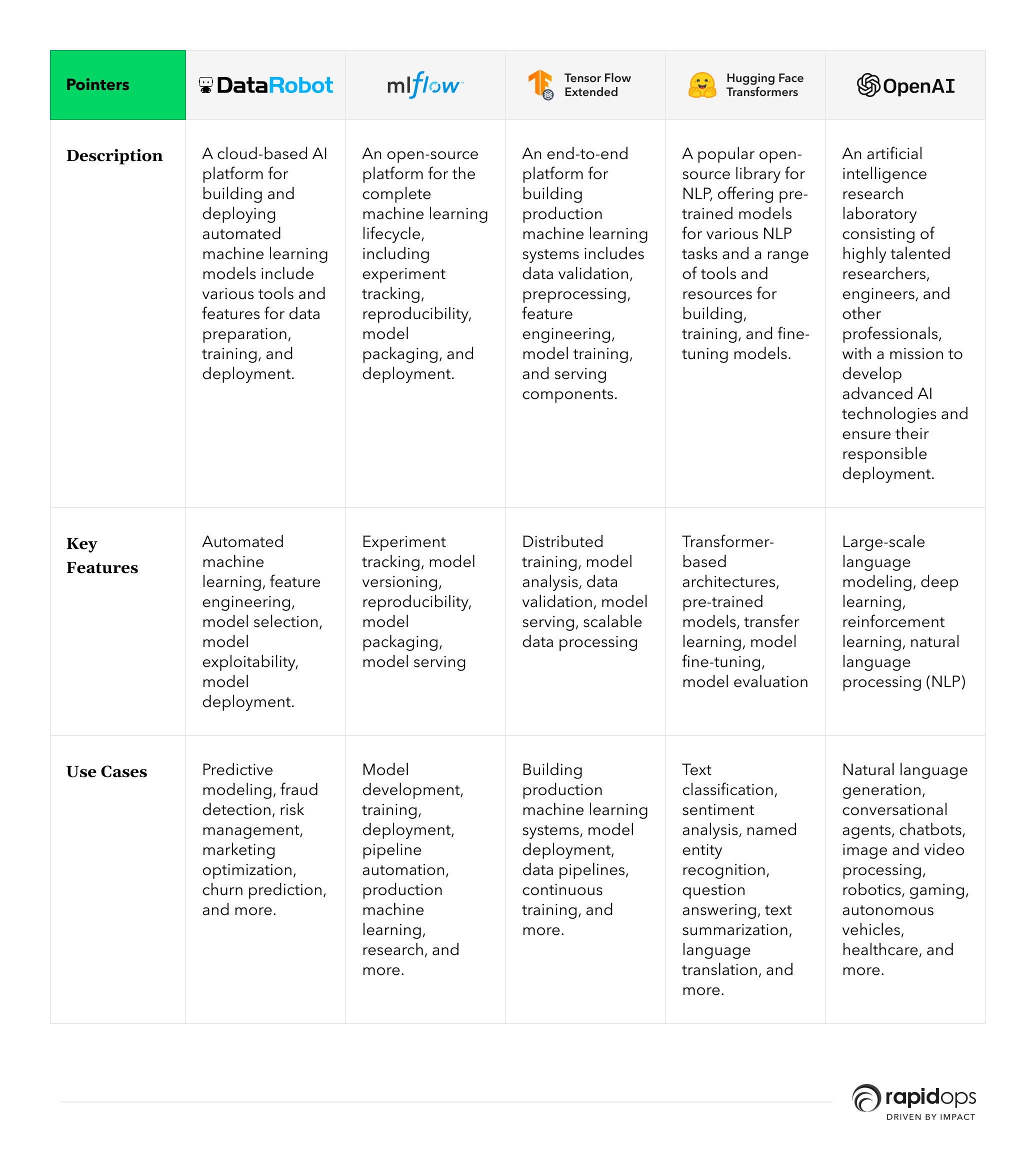
Content/Copywriting Domain
6. GPT-3
Developed by OpenAI, GPT-3 (Generative Pre-trained Transformer 3) is a powerful language model that uses machine learning to generate natural language text. It has been trained on massive data and can write articles, product descriptions, and poetry. While we are at it, let us tell you that GPT-3 and ChatGPT are two different platforms responsible for different sets if activities.
Check out this video added below to understand how GPT-3 works.
7. Copy.ai
Copy.ai is an AI-powered writing tool that helps users create high-quality content in seconds. Its algorithms are trained on millions of text samples to generate engaging and compelling content, including social media posts, blog articles, product descriptions, and more.
8. Jasper.ai
Jasper.ai (Formerly known as Conversion.ai) is an AI-powered writing tool that helps users generate content for marketing, SEO, social media, and more. Its algorithms can write articles, ads, and landing pages and even helps users with content research and creativity.
9. Writesonic
Writesonic is an AI-powered writing tool that helps users create marketing copy, social media posts, landing pages, and more. It uses GPT-3 to generate high-quality, engaging content and includes tone analysis and optimization features.
10. ContentBot
ContentBot is an AI-powered writing tool that helps users create content for blogs, social media, and e-commerce websites. It can generate product descriptions, social media posts, and blog articles, including sentiment analysis and language translation features.
If you are tired of staring at a blank screen while struggling to come up with fresh content ideas due to lack of that creative spark these Generative AI content tools will definitely come in handy.
Divergence: GPT-3 vs. Copy.ai vs. Jasper.ai vs. Writesonic vs. ContentBot

Designing domain
11. DALL-E 2
DALL-E 2 is a new version of the original DALL-E AI model developed by OpenAI. This advanced AI model can generate high-quality images from text descriptions and even generate novel images based on combinations of different concepts. DALL-E 2 is a breakthrough in artificial intelligence with many potential applications, including art, design, and advertising.
12. Lensa
Lensa is an AI-powered photo editing app that uses machine learning algorithms to automatically enhance and retouch portrait photos. It can remove blemishes, smoothen the skin, adjust lighting, and more, all with just a few taps.
It also includes features for adjusting hair color and style and can generate new hairstyles based on the user's preferences.
13. Midjourney
Midjourney is an AI-powered design platform that uses machine learning algorithms to help designers create unique and custom designs for websites and mobile apps. It uses a combination of user feedback and AI-generated suggestions to create designs that are both visually appealing and user-friendly.
Midjourney can help designers with font selection, color palettes, and layout design tasks. It's an excellent tool for designers who want to streamline their workflow and create high-quality designs quickly.
14. Craiyon
Craiyon uses advanced deep-learning algorithms to generate the most accurate and high-quality images based on user input. The fraternity considers it a revolutionary tool because it takes advantage of deep learning and machine learning to produce the most refined output.
15. NightCafe
NightCafe Studio uses machine learning algorithms to generate high-quality, diverse, realistic images. The company was founded by a team of technocrats who are or love art at NVIDIA. It uses a combination of styled-based and progressive growing techniques to produce images that are not only high in resolution but also demonstrate the soul of the art.
Each tool demonstrates AI's power and potential in image creation, photo editing, and design. Leveraging advanced machine learning algorithms can help users create high-quality visual content quickly and easily.
Face-off: DALL-E 2 vs Lensa vs Midjourney vs Craiyon vs NightCafe
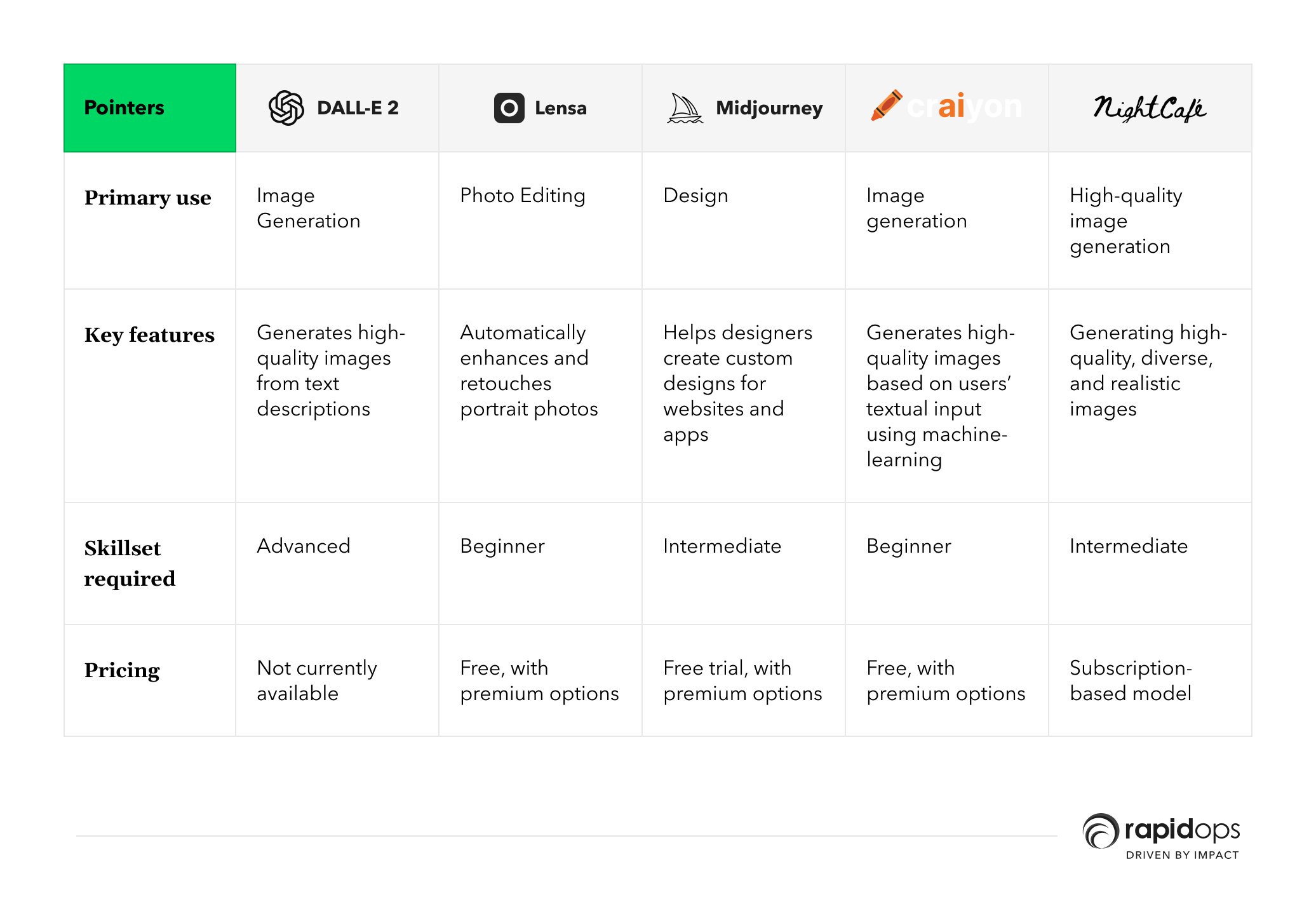
Video creation/editing domain
16. Synthesia
Synthesia is an AI-powered video creation platform that allows users to easily create and customize video content using synthetic media technology. Synthesia allows users to create realistic, professional-quality videos using pre-existing templates or upload their own video content. It allows users to create videos featuring realistic human-like avatars or virtual spokespeople that can deliver customized messages or presentations.
17. Lumen5
Lumen5 is an AI-powered video creation platform that can help users create engaging video content in minutes. It uses AI to generate video animations based on text and images, making it an excellent tool for creating social media videos, product demos, and explainer videos.
18. Magisto
Magisto is an AI-powered video editing tool that helps users create professional-looking videos in minutes. Its AI algorithms analyze and edit raw video footage to create a polished and engaging final product. Magisto is an excellent tool for creating marketing videos, social media ads, and video content for websites and blogs.
19. D-ID
D-ID stands for ™De-identification. It uses deep learning algorithms to produce high-quality and realistic videos based on the descriptions provided by users. The most significant advantage of D-ID is that it helps people fall prey to facial recognition and facial identification technology when privacy is the biggest concern, and they are compromising their data.
20. Descript
Descript uses a combination of Natural Language Processing (NLP) algorithms and Automatic Speed Recognition (ASR) for better workflows and easy transcriptions and analysis of audio and video files.
The key differentiator of Descript is that it automatically removes filler words like umm and uh from the recordings while offering collaboration tools to help work a team together on a single project.
These tools can assist with video creation and editing, but it's important to note that they are separate from human creativity and video production skills. Instead, they can be used as a starting point or to supplement existing video creation efforts.
21. Movavi Video Editor
Movavi Video Editor revolutionizes traditional editing with its AI-driven, non-linear approach, elevating your videos to a professional standard. It simplifies the editing process with AI tools that make creating stunning content effortlessly.
Key features include AI background removal (no green screen needed), AI noise removal for better audio, and various video effects for enhancing creativity on platforms like YouTube and social media.
Differentiation: Synthesia vs. Lumen5 vs. Magisto vs. Animoto vs. Descript
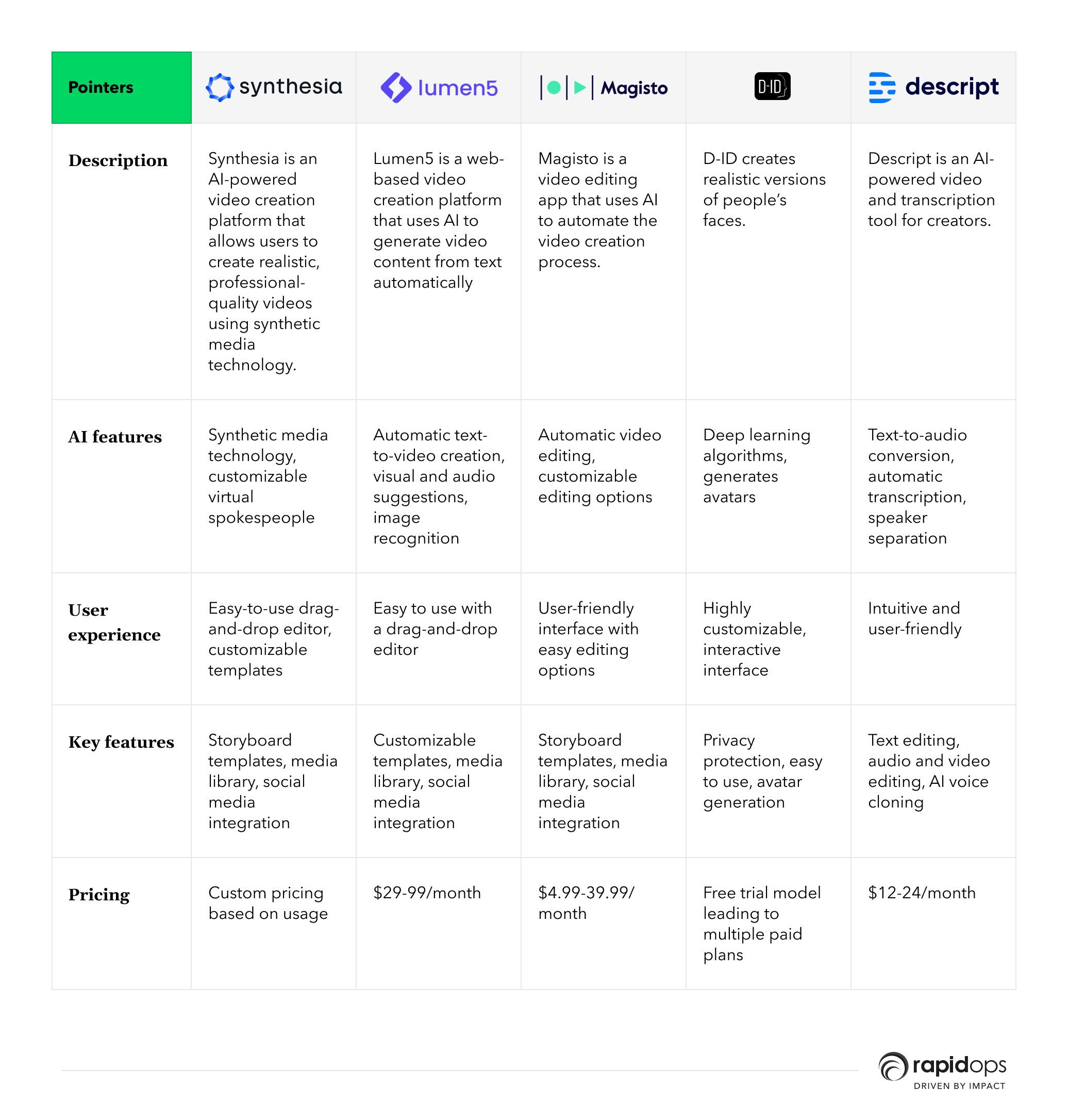
Coding domain
22. Replit Ghostwriter
Replit Ghostwriter uses machine learning to produce an accurate and high-quality output quickly. Using Natural Language Processing (NLP) technique, it suggests improvements and changes to users texts that are the majority of programming codes. Replit ghostwriter comes in handy for programmers for technical documentation and code enhancement.
23. TabNine
TabNine is a code completion tool that uses deep learning algorithms to provide highly accurate code suggestions. TabNine can be integrated with the most popular code editors and supports many programming languages. According to TabNine's website, the tool has over 1M users and has been shown to improve code completion accuracy by up to 2.7x.
24. DeepCode
DeepCode is an AI-powered code review tool that uses machine learning algorithms to identify potential issues and vulnerabilities in code. DeepCode can be integrated with GitHub and other popular code hosting platforms. According to DeepCode's website, the tool has analyzed over 1 billion code lines and identified over 50,000 security vulnerabilities.
25. Copilot
Copilot is a code generation tool developed by OpenAI and GitHub. It uses GPT-3, one of the most advanced natural language processing models available, to generate code snippets based on natural language descriptions. Copilot has a code completion rate of 78%, which is higher compared to the rate of 70%, where the copilot is not used.
26. Mutable AI
Mutable AI helps coders write clean code while saving time and increasing productivity. It analyses the codebase and recommends changes or improvements that make the code stable, reliable, and readable.
These AI-powered tools can be precious for developers looking to improve their productivity and code quality.
Dissimilarities among Replit Ghostwriter, TabNine, DeepCode, Copilot, and Mutable AI
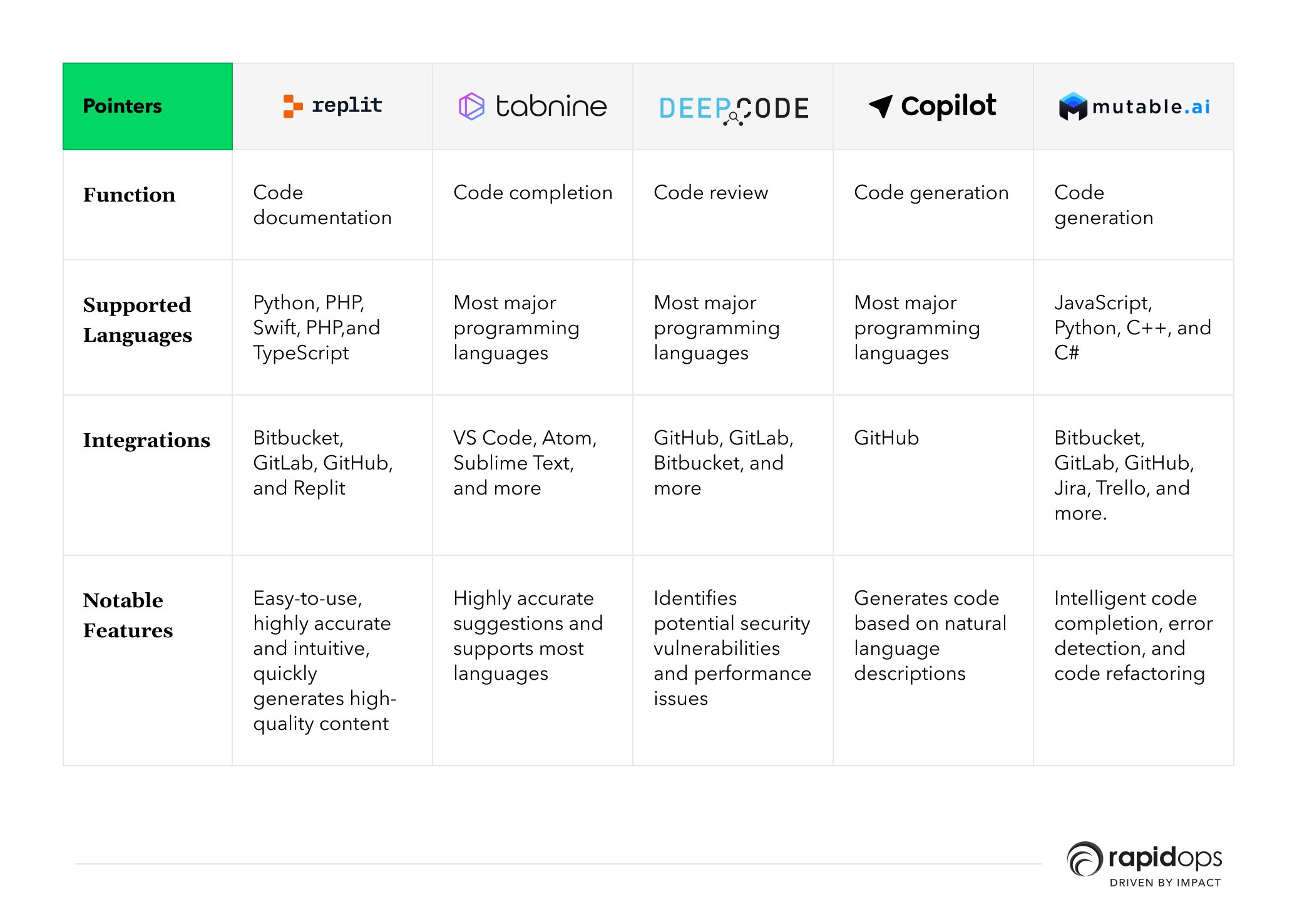
Drive your business forward with Rapidops
The global AI market is expected to reach $15.7 trillion by 2030, with the largest share of this growth coming from the creative and media industries. - PwC report
The age of AI is upon us, and the transformation is palpable. For businesses looking to stay ahead of the curve, adopting AI-powered tools can be a game-changer, propelling your workflow, content creation, and overall business operations to unprecedented heights.
From model infrastructure to content creation, designing, video editing, and coding, the extensive list of generative AI tools discussed here is proof of AI's disruptive power.
At Rapidops, we pride ourselves on staying at the forefront of digital innovation, harnessing AI's potential to deliver solutions tailored to our client's unique needs. If you're ready to take the plunge into the AI-driven future, we're here to guide you through every step.
The world is evolving, and AI is the engine driving this change. So, embrace the change, learn the dynamics, and sail your business through the transformative tide of AI with Rapidops. Reach out to us today and unlock your path to AI-enhanced growth!
Frequently Asked Questions (FAQ's)
In our FAQ section, we explore the fundamental aspects of generative AI, its popular models, its power, its users, and its various applications. We will now delve into a more detailed analysis.
What are generative AI tools?
What are generative AI tools?What are the popular generative AI models?
What are the popular generative AI models?What is the most powerful AI tool?
What is the most powerful AI tool?Who uses generative AI?
Who uses generative AI?How is generative AI being used today?
How is generative AI being used today?

Niyati Madhvani
A flamboyant, hazel-eyed lady, Niyati loves learning new dynamics around marketing and sales. She specializes in building relationships with people through her conversational and writing skills. When she is not thinking about the next content campaign, you'll find her traveling and dwelling in books of any genre!

Let’s build the next big thing!
Share your ideas and vision with us to explore your digital opportunities
Similar Stories
- AI
- 4 Mins
- September 2022

- AI
- 9 Mins
- January 2023


Receive articles like this in your mailbox
Sign up to get weekly insights & inspiration in your inbox.

